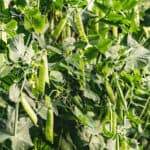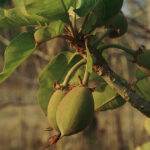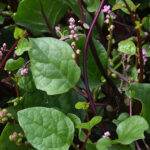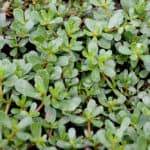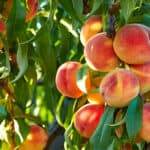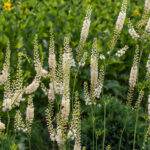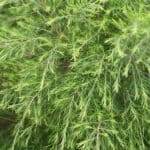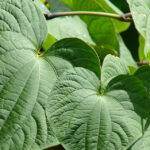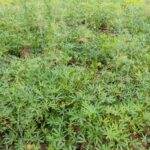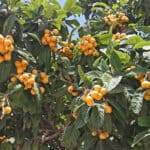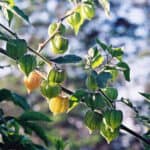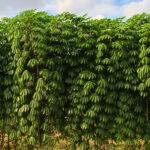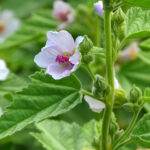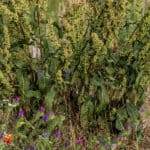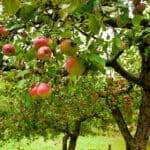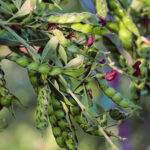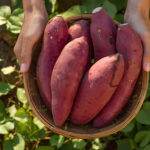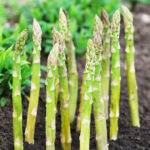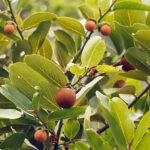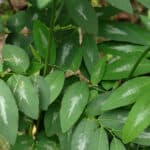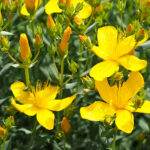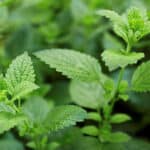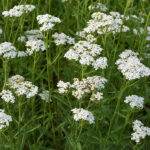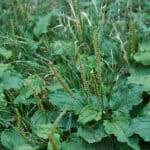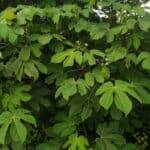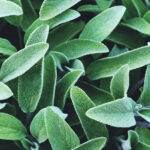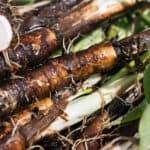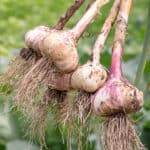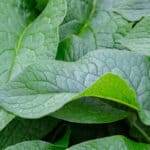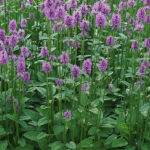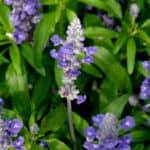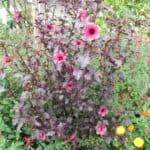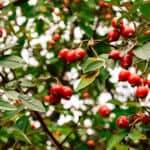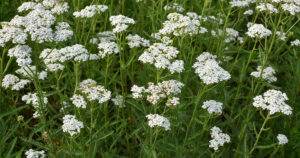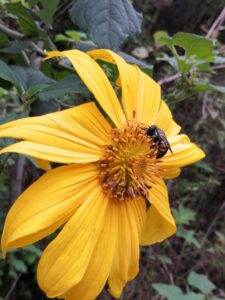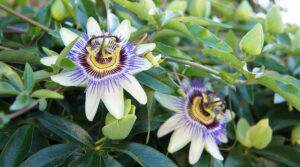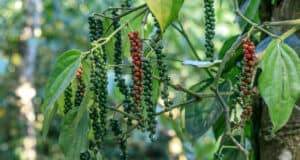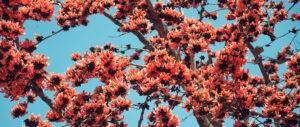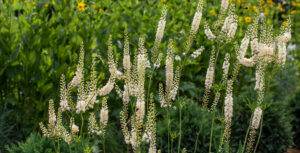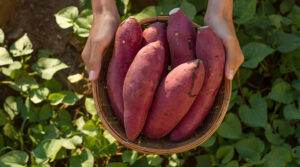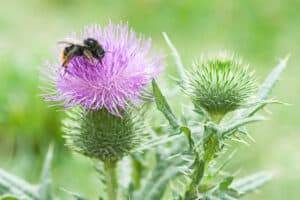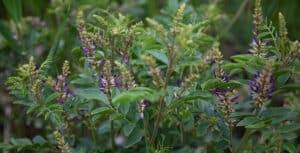The Gooseberry is another example of an edible plant that makes one wonder, Who was the first person who decided to eat that? Currant’s spiny cousins, Gooseberry plants do not seem immediately inviting, befitting their natural growth in alpine thickets and rocky woods. Somehow, this unlikely shrub won the favor, attention, and intervention of humans. It has since become a widely domesticated plant, whose reach is continuing to broaden.
Small, Mighty, and Sharp: The Gooseberry Family Shrub
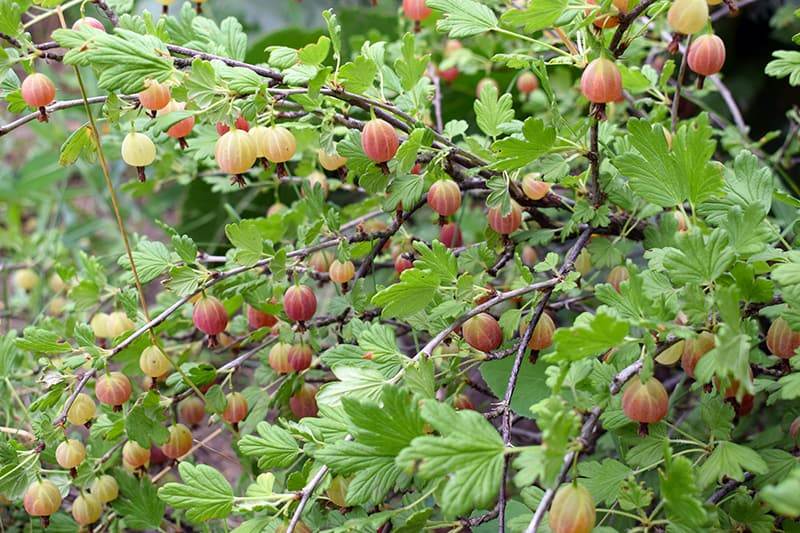
A small spiny bush, Gooseberries grow to about three feet tall, and at least as wide. They have deeply lobed dark green leaves and small bell-shaped flowers that hang individually or in clusters. Oval-shaped berries ripen to green, pink, white, yellow, purple, and red, and can reach the size of a small egg (though most range from pea to grape-sized). Woody stems feature thorny spines at every leaf node, and often more.
There are two branches to the Gooseberry family: European Gooseberries (Ribes uva-crispa), native to North Africa, Eastern Europe, and West Asia, and American Gooseberries (Ribes hirtellum), native to the Northern United States. While not much information is known about how these berries found their ways to domestication, a lot can be said about their two different paths in the time since.
European Gooseberries have enjoyed great popularity. And through extensive breeding and co-evolution with humans, they’ve also diversified greatly. From the 15th Century onward, Europeans have developed hundreds of different varieties of Gooseberries. In fact, the plant and its fruits became so popular that “Gooseberry Clubs” were formed in England, with the aim of growing the largest, most colorful berries.
Meanwhile, American Gooseberries, whose fruits are smaller and less flavorful, were – and are – used by Native Americans as both food and medicine. But they have not yet become as popular a domesticated plant as their European counterparts.
It seems that the future of Gooseberries lies in the crossing of their lineage. The disease resistance of Ribes hirtellum combined with the flavor and size of Ribes uva-crispa. For a plant that has already been bred extensively, this continued development could really extend its range and popularity.
Planting

For such a sturdy plant, Gooseberries are still quite selective about their placement. All plants in the Ribes family require in the range of one-thousand to twelve-hundred chilling hours (time spent below 45℉) in order to break dormancy. This rules out plantings in the deep South, Southern California, etc. While they require cold temperatures to wake them up, Gooseberries are also early bloomers, flowering weeks before strawberries do. Be sure to avoid planting them in low spots that are more susceptible to late-Spring frosts. Temperatures below 28℉ will damage flowers, and significantly reduce your berry crop for the year.
Gooseberries are also sensitive to extreme heat (temperatures that regularly break 85℉) as well as lots of intense sun; the combination leads to sunburn of leaves and fruit. Consider a planting that offers morning sun with partial shade throughout the afternoon. Northern/North-eastern sun exposure provides cooler air temps and soil in many scenarios. In a colder or mountainous environment, full sun could still be appropriate and may improve berry yields.
Gooseberries are more flexible where soil quality is concerned. They’re less picky about soil acidity than other berries. Heavy soils are tolerable, even preferable, so long as they are not mucky and water-logged. Gooseberries have a shallow root system, and do well with regular waterings. Consider a drip irrigation system that delivers about an inch of water per week. Drought stress can do significant damage to the plant’s leaves and buds.
Note: Plants in the Ribes family can be vectors for White Pine Blister Rust, a very serious disease that affects White Pines. A US Federal Ban on the planting of Gooseberries and Currants was placed in 1911 to protect the pines (and the timber industry). The ban has since been lifted, but individual states have their own rules and regulations around the planting of Ribes. Do your due diligence, and figure out what is allowed in your state. Certain cultivars are particularly resistant to White Pine Blister Rust.
Propagation
Seedlings
Gooseberry seedlings are widely available, and should be planted out in early Spring. Cut the plants back to a height of 6-10 inches at planting; this will help the bush to focus on the growth of roots and shoots. Space plants 3 feet apart to create a hedge of sorts, further if you’re looking to make guilds or rows, keeping in mind that air flow is important in reducing fungal diseases. Plant them at least an inch deeper than their nursery level to encourage new canes and promote a larger root system. Gooseberries are self-fertile, but pollination is always improved by planting more than one cultivar. Plants will fruit in 1-3 years.
Cuttings/Layering
Gooseberries can be propagated through taking cuttings in early Spring, just before the buds have opened. First, choose a vigorous first-year shoot. Then, cut a slanted top-cut just above a bud. Measure about 6 inches below, and make your bottom straight cut just below another bud. Apply rooting hormone powder to the bottom cut, and bury your shoot to half of its depth in a pot filled with soil mix. Keep your cutting well-watered as it roots, develops, and prepares itself for planting the next Autumn.
Alternatively, you can allow the plant itself to do the work of rooting by trying a technique called layering. Bend a vigorous shoot to the ground and cover its tip with soil. Keep this spot well watered, and the tip of the shoot will develop roots. Dig your new plant up for transplanting in the Fall.
Growth & Care
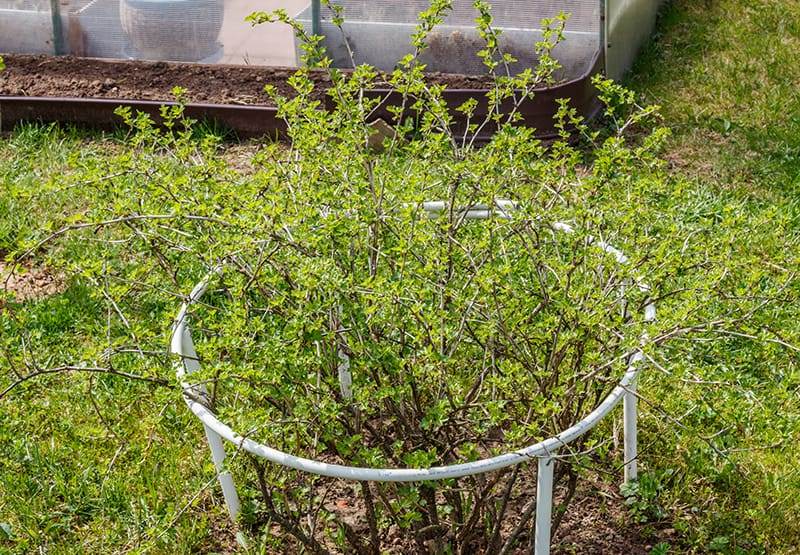
Mulch/Soil Amendments
A yearly re-mulching with wood chips helps Gooseberries to retain moisture, and also answers their needs for soils rich in potassium. Add a dressing of well-aged compost, but keep it light. Excess nitrogen makes the plants more susceptible to disease – mildew in particular. Lastly, if adjusting the pH of your soil upward (Gooseberries are happiest in the 5.5-6.5 range), use dolomitic lime, which also provides magnesium – another resource the plant appreciates in abundance.
Pruning
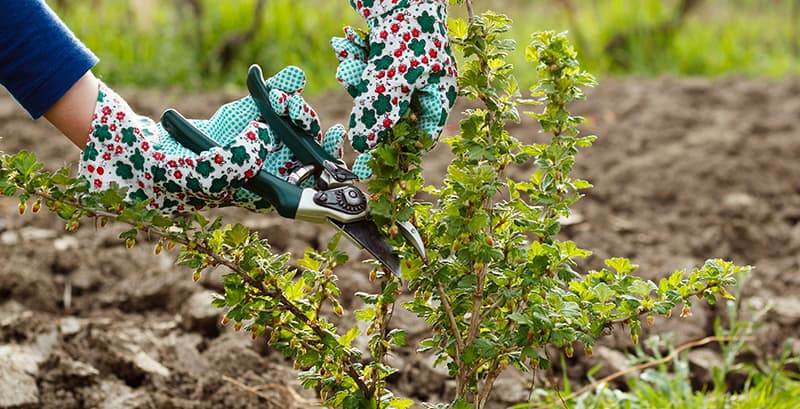
The permanent central crown of the Gooseberry puts forth new shoots yearly, at or near ground level. Allow these shoots and stems to grow for three to four years, and then begin to remove the oldest of them. Each Spring, cut away weak and crowding branches and leave a few stems from each year’s growth. Aim to have nine to twelve main stems once your Gooseberry bush is mature. The younger stems tend to have larger buds, and thus will provide bigger berries! Regular pruning and renewal will give you larger fruit and better air flow. AND, it opens up the thorny center of the bush, making harvest easier as well.
Pests
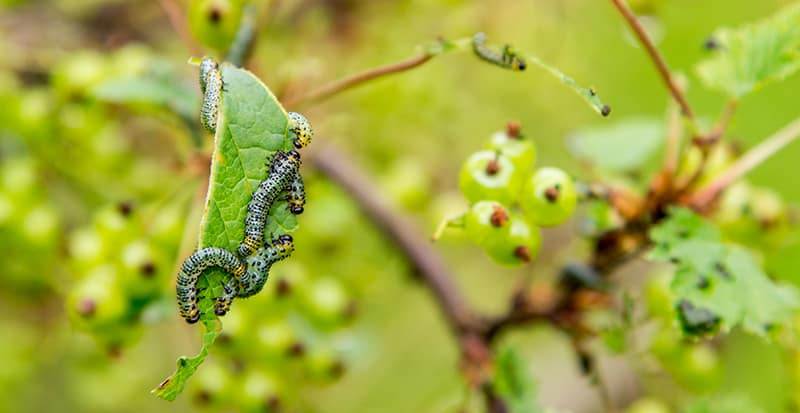
There are a few insect pests with a taste for the Gooseberry plant. The imported currant worm feeds primarily on the plant’s leaves, slowly in its first generation, and devastatingly after a second hatching. The eggs, placed on the undersides of leaves, and the fly who lays them, are fairly nondescript. Be on the lookout for green worms with dark spots on their bodies. An insecticidal soap can be helpful in ridding your plants of these pests. It’s also a best practice to cut out infested parts of the plant.
The gooseberry fruitworm moth lays eggs on unripened fruit. The light-green larvae burrow into the berries and feed, moving from one fruit to the next. Look for berries that color up prematurely and drop from the bush, as well as silk webbing between berries. The fruitworm only produces one generation per year, but can become a destructive perennial pest. Be sure to pick off and discard infested berries.
Last but certainly not least is the gooseberry maggot. These troublesome larvae develop inside the fruits themselves. An area of discoloration on the fruit shows where the egg was laid by a small brownish-yellow currant fruit fly. Remove the infested fruit as soon as you see evidence of that discoloration. Putting a tarp or cardboard under the plants will keep the pupae from finding a winter home in your soil. As a last resort, spinosad can be applied to kill back an extreme infestation. Keep in mind that even organic measures of pest control can be harmful to beneficial insects, and use them sparingly.
Row cover and netting can be used effectively as a physical barrier for both insect and bird pressure. Keep an eye out for mice and voles, who sometimes make a meal of the outer bark.
Disease
Gooseberries are susceptible to both anthracnose and mildew. Both fungal diseases are particularly harmful to the leaves of the plant, and mildew can also spread to the fruits. A holistic approach of good pruning practices, plant hygiene, and herbal teas/sprays can be very helpful as preventative measures. Michael Phillip’s book The Holistic Orchard has fantastic recipes for home orchard sprays that include such ingredients as molasses, neem oil, stinging nettles, and horsetail. These sprays are more preventative than reactionary, and focus on the health of the overall ecosystem.
A Spiky Harvest
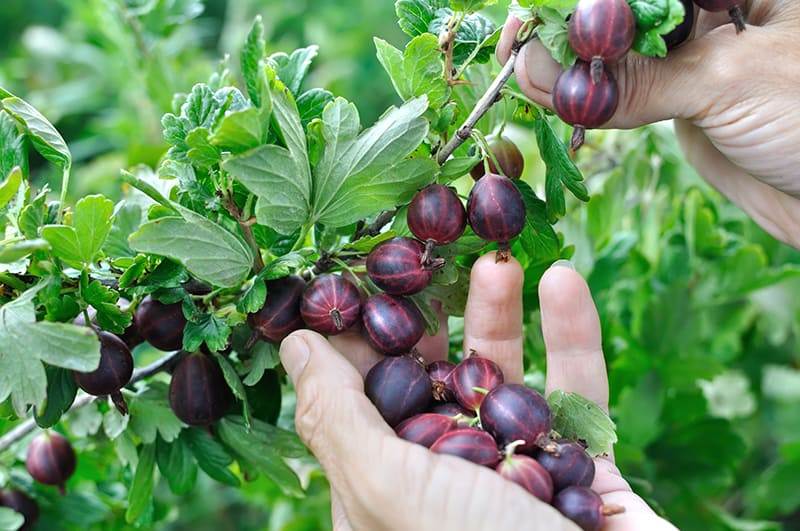
Gooseberries are harvested in late June to mid July, when the fruit is full-size, ripened to color, and has a softness to it. Depending on variety, the ripe fruit comes in a range of colors: green, pink, red, purple, white, and yellow. Some jam-makers pick their fruit a bit under-ripe when its pectin levels are high.
Gooseberries maintain their spiny thorns, so use caution during harvest – and be prepared to move a bit more slowly in your picking. Refrigerated berries, kept in a closed bag or container, will keep for several weeks. Or you can freeze them for long-term storage.
“Across the Pond” Preparations
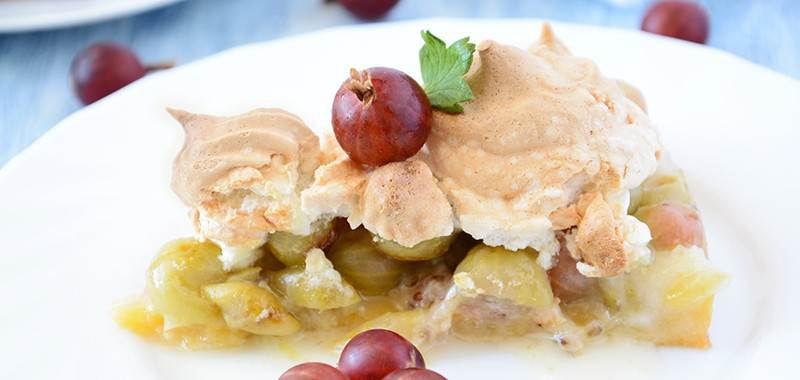
Not surprisingly, much of the information on how to cook or prepare Gooseberries comes from Britain. These tart fruits, high in Vitamin C, are grilled, pickled, fermented, made into lemonades and pies, added to cocktails, syruped, and even added to meat dishes. Perhaps the most popular preparation: gooseberry jam, an explosion of tart and sweet flavors.
Closing Thoughts
Gooseberries tell an interesting story of cultural favor and split opinion. Their evolution from an intimidatingly spiny wild plant to a household favorite is still in progress, but owes much to human interest and cultivation.

